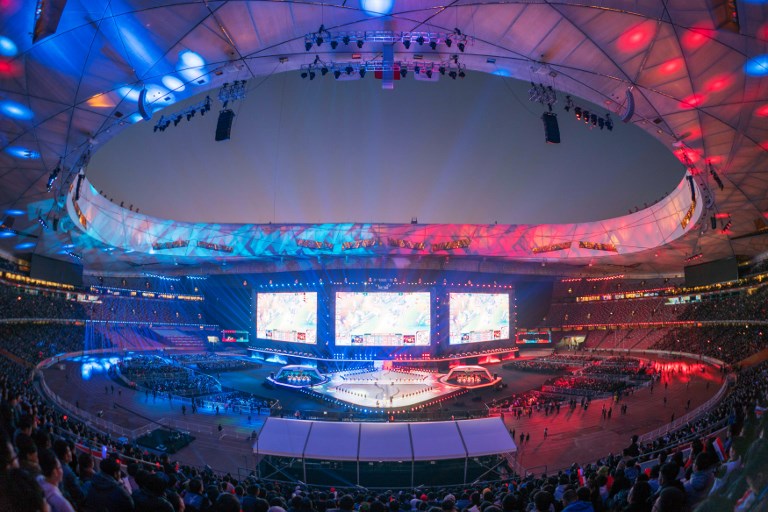Video game warriors do battle before 40,000 fans in China

A general view of the award ceremony of the World Championships Final of League of Legends at the National Stadium ‘Bird’s Nest’ in Beijing on November 4, 2017. AFP
BEIJING, China — More than 40,000 spectators, giant screens, players glued to their keyboards and more than $1 million prize money for the winners: welcome to the world of eSports in China, a country that has become a leader in competitive video game playing.
The final of the world championships for League of Legends, one of the most-played video games on the planet, took place Saturday in Beijing’s “Bird’s Nest”, the national stadium built for the 2008 Olympic Games.
“The atmosphere is great! It’s better than at home, no?” said Yu Yating, a 23-year-old customer service manager dressed in a cosplay outfit: long green wig, white minidress and a plastic golden scepter.
“I’ve been playing League of Legends since 2013 because I love the monster fights — it relaxes me,” she explained, as screams broke out in the stands when the competitors arrived, ready to do battle.
Soon, one of the players slaughtered a virtual dragon, prompting howls of excitement.
“Oh, huge!” said 19-year-old student Qian Feng, one of the spectators following the multi-player game on three giant screens that were practically the height of the stadium.
Two-thirds of the audience were male, between 15 to 35 years old. Some, like Qian, had travelled hundreds of kilometers to watch the final in person.
“eSports have taken off in China because all young people have a computer now,” he said.
“When I have school, I play League of Legends with my friends an hour a day, otherwise we play all afternoon.”
Tickets for the event cost between 280 to 1,280 yuan ($40 to $190) and sold out in minutes, with touts hawking them on the black market for up to 13,000 yuan.
The size of the audience for the League of Legends final, a game owned by Chinese internet giant Tencent, matched that of the 2017 Europa League final between Manchester United and Ajax — without including the tens of thousands of fans streaming the match live through specialist websites.
‘A computer is enough’
The packed event showcased China’s ambition to become the world leader for electronic sports, or eSports.
The fast-growing sport sees teams of professional video game players fight for large sums of money in front of an audience, usually in multipurpose arenas or stadiums. And its popularity is only expected to grow.
There are currently 191 million eSports fans around the world, and numbers are projected to increase by 20 percent by 2020, according to video game specialists Newzoo.
As purists question if video games even qualify as a sport, eSports are inching closer to official recognition after last weekend’s meeting of Olympic representatives in Lausanne, Switzerland left open the possibility for a future Olympics event.
Meanwhile eSports is set to have its own category at the 2022 Asian Games in Hangzhou in China. That comes as little surprise since Asia is a fast-growing market for video games.
“I also play traditional sports, badminton,” said Li Hangtian, a 22-year-old student.
“But China is very populous, it is sometimes difficult and expensive to reserve a court, whereas I can practice eSports with my roommates where and when I want: a computer is enough.”
Enthusiasm for the games shows no sign of slowing down. Global turnover from eSports is currently $696 million, with Newzoo saying it will climb to $1.5 billion in the next three years.
And Asia could be its future, with China currently accounting for “around 15 to 20 percent of global eSports revenue”, said Ignat Bobrovich, chief executive of TwogNation, an international eSports management agency.
“North America is the biggest market for now, at 35 to 40 percent. But in two years’ time, Asia, which is home to half the world’s eSports fans, will easily outstrip this,” he added.
Indeed, Saturday’s face-off featured two South Korean teams, with Samsung Galaxy vanquishing SK Telecom T1 3-0 and pocketing around $1.7 million in winnings. /cbb